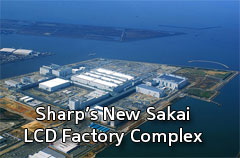Second, the company has taken the concept of just-in-time inventory from suppliers a step further. Key vendors have their own manufacturing operations directly within the complex, which are fully integrated into plant operations.
For example, the glass panels are made by Corning at a plant next to Sharp's LCD factory and transported on a conveyer that connects the two operations. Across the street, Dai Nippon Printing and Toppan have factories that produce color filters for the LCD panels.
All told, some 19 vendors have operations somewhere on site. Of the 2000 workers at the complex currently, half are Sharp employees, and half toil at its suppliers’ operations. Eventually, the entire complex will employ some 5000 workers. Sharp says itself and the vendors will work as “one virtual company.” The vendors built and paid for their own facilities and rent the land from Sharp.
But if the vendors can produce more from its facilities in the complex than Sharp wants to buy, the suppliers are free to sell the products they make in Sakai to other companies.
There was a significant effort to link Sharp’s supply chain and procurement systems with those of the suppliers. “Kanban” signals and purchase orders are delivered in real time as production proceeds around the clock.
The factory also employs substantial levels of automation. AGV robots, for example, move the sheets of glass no thicker than a credit card into finishing ovens.
Elsewhere, even larger robots pick up crates holding 50 sheets of glass and whisk them to other areas of the factory for processing. A variety of automated systems constantly check for potential quality issues. Virtually all movement of product from the on-site vendors to Sharp’s operations are done either by conveyor or automated trolley – no trucks.
 The new plant complex is also a highly “Green” operation. The new plant complex is also a highly “Green” operation.
The 100,000 tons of water required per month to wash down the glass is recycled and used again and again. A central energy control center collectively manages the energy needs of all the factories on the site. Solar panels on the factory roofs supply 9 megawatts of power, a level that will be doubled over time.
Though these and other details are known, and Sharp did open up the factory to reporters earlier this month, there is still much secrecy around actual operations. Reporters were barred from bringing in cell phones, cameras and audio recorders. The response to many questions was, “We can’t tell you that.”
The gamble is not without doubters. The plans were put into place two years ago, when demand for panels may have been near a peak. The fickle nature of consumer demand and fast-paced technology change in the industry could mean the operation is less competitive or even obsolete much sooner than the projections used to justify the investment.
Even suppliers were hesitant. A Corning executive said it was leery of making the investment in part because, right now, the only customer for the larger size sheets of glass is Sharp. In the end though, it moved forward.
However, competitor and customer Sony apparently likes the idea. Before the end of the year, it will invest 10 billion yen for a 7 percent stake in Sharp Display Products, the company that runs the factory, and gradually build its stake to 34% by the end of April 2011.
Samsung Electronics says it is considering building a new LCD-panel factory using even bigger glass sheets than Sharp, while LG Display says it plans to build a new factory in China using current glass size.
What is your reaction to the Sharp factory complex? Smart investment – or too much given the changing market? Can it enable Sharp to keep competitive with lower cost countries? Do you think we will see more total integration of suppliers with customer manufacturing plants? Let us know your thoughts at the Feedback button below.
SCDigest is Twittering!
Follow us now at https://twitter.com/scdigest
|